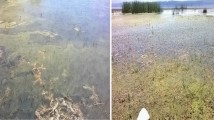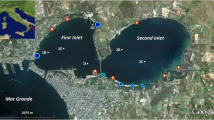Abstract
The big Comacchio lagoons (NW Adriatic coast) have been experiencing a super-dense, long-term bloom of picocyanobacteria (PCB) since 1985. This bloom has caused profound transformations in their ecosystem and has resulted in the loss of valuable fish and clam resources. The composition, density and seasonal dynamics of this bloom and its impact on the ecosystem were studied between spring and autumn 1995 and in the summer of 2001. The density of the blooming phytoplankton assemblages varied from 8 to 35 × 106 cells ml−1, and biomass from 20 to 40 g m−3, thus demonstrating a quasi-stable status since 1993. The share of pico + nanocyanobacterial fraction of the total phytoplankton biomass was 98% in spring to early summer, and 92% in autumn. The remaining 0.2–5% comprised eukaryotic nano-algae. All components of the animal food web were found to be drastically depleted in the lagoons. Their biomass range in the open lagoons areas were: 2 to 20 mg m−3 of microzooplankton, 10 to 40 mg m−3 mesozooplankton, and 5 to 12 g m−2 macrozoobenthos. The share of filtering fauna in the whole ecosystem metabolism was less than 2%. The malfunction of the deteriorated animal food web resulted in the hyper-accumulation of non-grazed microplankton biomass and detritus in the water column and in bottom sediments. The sequence brought the acceleration of sulfide production and the accumulation of acid soluble sulfides in the upper sediment layer of up to 700–800 mg S dm−3 of wet silt. The results of this study provide evidence that the state of ecological collapse continues in the lagoons since 1993.
Similar content being viewed by others
References
Afrikova, S. G., S. V. Lutzarev and T. S. Petipa (1977): Direct estimation of the individual carbon content in ooplankton species. Biol. of the Sea, Kiev, 42, 44–48 (in Russian).
Agawin, N. R. S., C. M. Duarte and S. Aguisti (1998): Abundance of Synechococcus in Mediterranean bay. Mar. Ecol. Prog. Ser., 170, 45–53.
Al Layl, K. J. (2002): Phylogenetic analysis of the toxsic cyanobacterium Synechocystis sp. J. Sci. Med. Eng., 14(1), 23–30.
Andreoli, C., E. Bresciani, I. Moro, L. Scarabel, N. La Rossa, L. Dalla Valle and F. Ghion (1999): A survey of persistent greenish bloom in the Comacchio lagoons. Bot. Mar., 42, Kiev 467–479.
Aquae transizionale (2008): Annulare 2008, ARPA, Emilia Romagna, Ferrara, 150 pp.
Bláha, L. and B. Maršálek (1999): Microcystin production and toxicity of picocyanobacteria. Algol. Stud., 92, 95–108.
Carmichael, W. W. (1997): The cyanotoxins. Adv. in Botanical Res., 27, 211–226.
Caron, D. A. (1983): Technique for enumeration of nanoplankton using epifluorescence microscopy. App. Environ. Microbiol., 40, 491–498.
Ceccherelli, V. U. (1976): Observations on zooplankton of Valli di Comacchio: the copepods. Arch. Oceanol. Limnol., 18(Suppl. 3), 411–424.
Ceccherelli, V. U. and I. Ferrari (1982): Annual and seasonal variations of zooplankton in a shallow-water lagoon system, Valli of Comacchio. Estuar. Coast. Shelf Sci., 14, 337–350.
Ceccherelli, V. U., M. A. Colangelo and E. A. Fano (1998): Evoluzione dei populamenti bentonici nelle valli di Comacchio. Laguna (Ferrara), 5(Suppl.), 36–47.
Chorus, J. (2001): Cyanotoxins. Springer, Heidelberg, 357 pp.
Cline, J. D. (1969): Spectrophotometric determination of hydrogen sulfide in natural water. Limnol. Oceanogr., 14, 454–456.
Cognetti, G., C. M. De Angelis and E. Orlando (1975): Attuale situazione, ecologica delle valli di Comaccio. Quaderni di Itala Nostra., 12, 1–55.
Colombo, G. and V. Ceccherelli Gianti (1977): Biomassa macrobentonica delle Valle di Comacchio. Atti IX Cong SIBM, Lacco Ameno d’Ischia, 199–211.
Crema, R., D. Prevedelli, A. Valentini and A. Castelli (2000): Recovery of the macrobenthic community of the Comacchio lagoon system (Northern Adriatic Sea). Ophelia, 52, 143–152.
Dallocchio, F., F. Ghion, C. Milan and P. Viaroli (1998): Charatteristiche chimicofische delle aquae delle Valli di Comacchio. Laguna (Ferrara), 5(Suppl.), 4–16.
Feletti-Spadazzi, A. (1957): Comacchio e sue Valli. Soc. Tip. Edit. Bologna, 150 pp.
Ferrari, C., A. Pirola and F. Piccoli (1972): Saggio cartographico della vegetacione delle Valle di Comacchio. Atti Universita di Ferrara. Sezione di Ecologia, 1, 35–54.
Gray, J. S. and G. R. Wurs (2002): Effect of hypoxia and organic enrichment on the coastal marine environment. Mar. Ecol. Prog. Ser., 238, 249–279.
Greze, V. N. (1978): Production in animal populations. p. 89–114. In Marine Ecology, 4, ed. by O. Kinne, Wiley, London.
Hobbie, J. E., R. J. Daley and S. Jasper (1977): Use of Nuclepore filters for counting bacteria by fluorescent microscopy. Appl. Environ. Microbiol., 33, 1225–1228.
Johnson, P. W., X. Huai-Shu and J. Sieburth (1982): Utilization of chrococcoid cyanobacteria by protozooplankters but not by calanoid copepods. Ann. Inst. Oceanogr. Paris, 58(Suppl.), 297–308.
Klut, E. M. and J. G. Stockner (1991): Picoplankton associations in a Vancouver lake. Can. J. Fish. Aqua. Sci., 48, 1092–1099.
Komarek, J. (1996): Taxonomic and species delineation of picoplanktonic cyanoprocaryotes. Algol. Stud., 83, 119–179.
Mistri, M., G. Fano and K. Rossi (2000): Macrobenthos in the Valli di Comacchio. Estuar. Coast. Shelf Sci., 51, 599–611.
Mitsui, A., D. Rosner and Goodma (1989): Hemolythic toxins in marine cyanobacterium Synechococcus sp. p. 367–370. In Proc. Int. Symp. on Red Tides, Miami 1987, Elsevier, New York.
Munari, C. S., F. Moduno and G. Ghion (2003): Recovery of the macrobenthic communities in the valli di Comacchio, Northern Adriatic, Italy. Oceanol. Acta, 26, 67–75.
Munari, C. S., R. Rossi and M. Mistri (2005): Temporal trends in macrobenthos community structure and redundancy in a shallow coastal lagoon (Valli di Comacchio, Northern Adriatic Sea). Hydrobiologia, 550, 95–104.
Oudra, B., M. Loudiki and V. Vasconcelos (2002): Microcyctins from cyanobacteria in reservoirs of Morocco. Environ. Toxicol., 17, 32–39.
Parsons, T. R., Y. Maita and C. M. Lalli (1984): A Manual of Chemical and Biological Methods for Sea Water Analysis. Pergamon, New York, 420 pp.
Passoni, S. and C. Callieri (2000): Picocyanobacteria single forms aggregated and microcolonies. Verh. Int. Verein. Limnol., 27, 1879–1883.
Piccoli, F. (1998): Vegetazione delle Valli di Comacchio. Laguna (Ferrara), 5(Suppl.), 24–27.
Riegman, R. and L. R. Mur (1986): Phytoplankton growth and phosphate uptake for P-limitation. Limnol. Oceanogr., 31, 983–988.
Rippka, R. (1972): Photoheterotrophy and chemoheterotrophy among unicellular cyanobacteria. Arch. Microbiol., 87, 93–98.
Rosenberg, C. M. (1985): Eutrophication-the future marine coastal nuisance-. Mar. Pollut. Bull., 16, 227–231.
Rossi, R. and S. Cataudella (1998): La produzone ittica nelle valle di Comacchio. Laguna (Ferrara), 5(Suppl.), 67–83.
Sellner, K. G. (1997): Physiology and toxic properties of marine cyanobacteria blooms. Limnol. Oceanogr., 42, 1098–1104.
Simek, K., P. Hartman and J. Nedoma (1997): Picoplankton grazing and zooplankton control of heterotrophic microflagellates. Aquat. Microb. Ecol., 12, 49–63.
Sorokin, P. Yu., Yu. I. Sorokin, R. Boscolo and O. Giovanardi (2004): Bloom of picocyanobacteria in the Venice lagoon during summer-autumn 2001: ecological consequences. Hydrobiologia, 523, 71–85.
Sorokin, Yu. I. (1999a): Radioisotopic Methods in Hydrobiology. Springer, Heidelberg, 326 pp.
Sorokin, Yu. I. (1999b): Aquatic Microbial Ecology. Backhuys, Leiden, 245 pp.
Sorokin, Yu. I. and M. Bilio (1981): Studies of microbial sulfate reduction and microplankton in fish culture ponds of the Comacchio region. Biol. of the Sea, Vladivostok, 2, 50–58 (in Russian).
Sorokin, Yu. I. and R. Boscolo (2002): La moria di vongole nell’ estate 2001 in Laguna di Venezia. Revista di Studie Researche (Chiggia), 20, 55–60.
Sorokin, Yu. I. and O. N. Burkatsky (2007): Labile sulfides content in bottom sediments of the central Sea of Azov: impact on the zoobenthos. Oceanology (Moscow), 47, 728–735.
Sorokin, Yu. I. and F. Dallocchio (2008): Dynamics of phosphorus in the Venice lagoon during a picocyanobacteria bloom. J. Plankton Res., 30, 1019–1026.
Sorokin, Yu. I. and O. Giovanardi (1995): Trophic charcteristics of the clam Tapes philippinarum. ICES J. Mar. Sci., 52, 853–862.
Sorokin, Yu. I. and P. Yu. Sorokin (1999): Analysis of lagoonal ecosystem in the Po river delta associated with intensive auqculture. Estuar. Coast. Shelf Sci., 48, 325–341.
Sorokin, Yu. I., P. Yu. Sorokin and A. Gnes (1996a): Structure and functioning of anthropogenically transformed Comacchio lagoon ecosystem. Mar. Ecol. Prog. Ser., 133, 57–71.
Sorokin, Yu. I., F. Dallocchio, F. Gelli and L. Pregnolato (1996b): Phosphorus metabolism in anthropogenically transformed lagoon ecosystems: Comacchio lagoons. J. Sea Res., 35, 243–260.
Sorokin, Yu. I., P. Yu. Sorokin and O. Yu. Zakuskina (1998): Microplankton and its function in zones of shallow hydrotherms of the Western Pacific. J. Plankton Res., 20, 1015–1031.
Sorokin, Yu. I., P. Yu. Sorokin and G. Ravagnan (2006): Hypereutrophication events in the Ca’Pisani lagoons associated with intensive aquaculture. Estuar. Coast. Shelf Sci., Hidrobiol., 571, 1–15.
Stockner, Y. J., C. Callieri and G. Cronberg (2000): Picoplankton and other non bloom-forming cyanobacteria in lakes. p. 125–231. In The Ecology of Cyanobacteria, ed. by B. Whitton and M. Potts, Kluwer, Dordrecht.
Tchislenko, L. L. (1968): Nomograms for Estimations the Weight of Aquatic Animals after Their Firm and Size Parameters. Nauka, Leningrad, 105 pp. (in Russian).
Todini, E. and A. Bizzarri (1988): Eutrophication in the coastal area of Emilia Romanga. UNESCO Bull. Mar. Sci., 49, 143–152.
Viaroli, P., R. Azzoni and G. Giordani (2001): Trophic conditions and dystrophic outbrakes in the Sacca di Goro lagoon. p. 125–231. In Mediterranean Ecosystem, ed. by F. M. Farranda, Springer, Italy.
Vismann, B. (1991): Sulfide tolerance: physiological mechanisms and ecological implications. Ophelia, 34, 1–27.
Vollenveider, R. (1992): Marine Coastal Eutrophication. Elsevier, Amsterdam, 950 pp.
Zaika, V. E. (1973): Specific Production in Aquatic Animals. Wiley, London, 170 pp.
Zore, M. (1958): Some new observations on the system of Adriatic currents. Rapp. P-V. RCIESM, 14, 47–54.
Author information
Authors and Affiliations
Corresponding author
Rights and permissions
About this article
Cite this article
Sorokin, Y.I., Zakuskina, O.Y. Features of the Comacchio ecosystem transformed during persistent bloom of picocyanobacteria. J Oceanogr 66, 373–387 (2010). https://doi.org/10.1007/s10872-010-0033-9
Received:
Revised:
Accepted:
Published:
Issue Date:
DOI: https://doi.org/10.1007/s10872-010-0033-9




